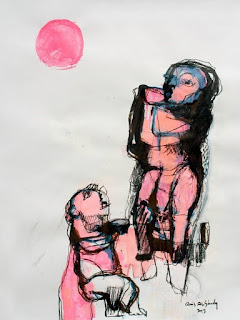I am so lucky to have many
friends who are artists. For many of
them, despite the hardships, this time of quarantine has given them a period to
explore their creativity in new ways.
They are “relooking” (A French word, believe it or not, even if not
officially sanctioned by the Académie Française) their art or their process, experimenting in
new directions, addressing issues of
reuse and recycling born out of environmental concern, but nurtured by the
present scarcity of available materials (one artist posting that she is
painting over older work, reusing the canvas
to express new concepts). The
gift of time can be inventiveness.
But I have come to realize
that all my friends are artists, in one way or another. My friend, artist Mona El-Bayoumi said it
best, “Like everyone else I was born an artist, but I seriously continued to
express myself since.” She believes, as
do I, that we are all born artists. We
create our world with every childhood act, because everything we do as
children, a thing, a thought, a sound is created for the very first time,
unique to us. Then some of us grow up,
and circumstances and inclination move us away from our artistic roots, but our
artistic souls remain, dormant within us.
Corona has brought with it
much pain and heartache but has also awakened that dormant creativity in many
of us.
In her 1982 essay Material
as Metaphor, fiber artist Anni Albers said “Most of our lives we live
closed up in ourselves, with a longing not to be alone, to include others in
that life that is invisible and intangible. To make it visible and tangible, we
need light and material, any material. And any material can take on the burden
of what had been brewing in our consciousness or subconsciousness, in our
awareness or in our dreams.”
A longing not to be alone,
to include others, defines perfectly our covid-contained lives. Making takes on new meaning, as people bake
bread, sew masks, build backyard amusement parks for their children, compose
poetry, sing, keep diaries, and yes, draw and paint and sculpt and quilt and
stitch and weld and use light and materials, any materials, to express
themselves, to comfort themselves, to release the creativity with which they
were born.
We are making it, in both
senses of the word, making the bread or the painting or the pillow fort, and
making it through these horrific times. Art truly does heal.
I offer a colorful
construction seen in Australia. Make of
it what you will.
















